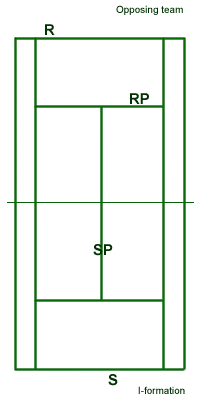The serving team uses the I-Formation to put pressure on the receiver.
The receiver must quickly make an aggressive and decisive return while considering the threat of the opposing net player and his possible direction of movement.
This tactic distracts the returner’s attention from watching the ball and frequently produces unforced errors.

Return of serve placement against a team using the I-Formation:
1. Attack the middle of the court – considering that both, the opposing net and baseline players, move away from the middle right after the serve, a low return down the center can be an excellent choice.
2. Return down the line aiming for the singles sideline with an aggressive topspin shot.
3. Chip the return down the line towards the intersection of service line and singles sideline. To do so, take the ball early (on the rise) and try to keep it low in the opposite court. The idea is not to hit it hard, just keep it low so that whoever reaches will have to hit it up.
The receiver’s partner should position at the service line or behind it, and a little closer to the sideline, in anticipation that the opposing up player could poach right at him.
By staying further back, the receiver’s partner will have more time to react to an eventual attack from the opposing up player.
Also, positioning himself closer to the sideline will send, to the opposing team, the message that the returner is contemplating the cross-court (which makes the I-formation team consider covering the wide angles).